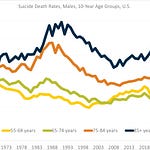I look at an opinion piece by fellow actuary Larry Pollack, on the new low-default pension obligation measure that is to be added to actuarial reports for public pensions in the U.S. These should start coming out in 2024.
Episode Links
Larry Pollack: New Disclosure Rules Expose Bad Actuarial Finance; Obscures Trillions of Public Pension Debt
Actuarial finance assumes away the cost of the guarantee, but real finance doesn’t work that way.
….
The Actuarial Standards Board, which defines professional standards for actuaries, finally acknowledged the criticisms and adopted a requirement for actuaries to calculate and disclose – starting with funding reports to be published (mostly) in 2024 – a liability measure more consistent with finance principles. The new measure provides valuable information not previously available, although it is not perfect, and, importantly, it will not affect actuarially-determined contributions or financial accounting.
Further, many prominent and influential public pension actuaries are rejecting this opportunity to educate their clients and the public about how much worse the funding of public pensions is versus what’s commonly reported. Instead, these actuaries have aligned with major public pension advocacy groups in developing a toolkit as part of a campaign to help actuaries and public officials divert attention from the significance and implications of the new figure. Among other things, the toolkit provides model explanatory language for actuarial reports, including the misleading assertion that the difference between the new measure and the current one represents “expected taxpayer savings” from investing in risky assets, rather than heretofore hidden public debt.
John Bury: New Disclosure Rules Expose Bad Actuarial Finance; Obscures Trillions of Public Pension Debt
So what is it the ASB wants actuaries to disclose? Slides from a recent Conference of Consulting Actuaries webinar provide a good overview. Excerpts below:
New required calculation and disclosure when performing a funding valuation: Low-Default-Risk Obligation Measure (LDROM) (page 9)
If the actuary concludes, based on the assessment required that the Contribution Allocation Procedure (CAP) or plan’s funding policy is significantly inconsistent with the plan accumulating adequate assets to make benefit payments when due, disclose that conclusion as well as an estimate of the approximate time until assets are depleted. (page 24) – wondering where they could have gotten this idea.
John Bury November 2010: RNSP (2) – Drop-Dead Dates for State Pensions
Earlier this year Joshua D. Rauh of the Kellogg School of Management at Northwestern University released a paper that set drop-dead dates for selected state pension plans to which the government-plans community objected. I too had my doubts about Professor Rauh’s methodology and assumptions and, having recently done my own study of 110 public pension plans, decided to embark on a similar study.
Conference of Consulting Actuaries: ASOP 4 Updated Guidance
ASOP 4: MEASURING PENSION OBLIGATIONS AND DETERMINING PENSION PLAN COSTS OR CONTRIBUTIONS
3.11 LOW-DEFAULT-RISK OBLIGATION MEASURE
When performing a funding valuation, the actuary should calculate and disclose a low-default-risk obligation measure of the benefits earned (or costs accrued if appropriate under the actuarial cost method used for this purpose) as of the measurement date. The actuary need not calculate and disclose this obligation measure more than once per year.
When calculating this measure, the actuary should use an immediate gain actuarial cost method.
When calculating this measure, the actuary should select a discount rate or discount rates derived from low-default-risk fixed income securities whose cash flows are reasonably consistent with the pattern of benefits expected to be paid in the future. Examples of discount rates that may meet these requirements include, but are not limited to, the following:
US Treasury yields;
rates implicit in settlement of pension obligations including payment of lump sums and purchases of annuities from insurance companies;
yields on corporate or tax-exempt general obligation municipal bonds that receive one of the two highest ratings given by a recognized ratings agency;
non-stabilized ERISA funding rates for single employer plans; and
multiemployer current liability rates.
When plan provisions create pension obligations that are difficult to appropriately measure using traditional valuation procedures, such as benefits affected by actual investment returns, movements in a market index, or other similar factors, the actuary should consider using alternative valuation procedures such as those described under section 3.5.3 to calculate the low-default-risk obligation measure of those benefits earned or costs accrued as of the measurement date.
For purposes of this obligation measure, the actuary should consider reflecting the impact, if any, of investing plan assets in low-default-risk fixed income securities on the pattern of benefits expected to be paid in the future, such as in a variable annuity plan.
When calculating this measure, the actuary should not reflect benefit payment default risk or the financial health of the plan sponsor.
Other than the discount rate or discount rates, the actuary may use the same assumptions used in the funding valuation for this measure. Alternatively, the actuary may select other assumptions that are consistent with the discount rate or discount rates and reasonable for the purpose of the measurement, in accordance with ASOP Nos. 27 and 35.
The actuary should provide commentary to help the intended user understand the significance of the low-default-risk obligation measure with respect to the funded status of the plan, plan contributions, and the security of participant benefits. The actuary should use professional judgment to determine the appropriate commentary for the intended user.
Related posts
Jan 2020: Revisiting Actuarial Standards: ASOP 4 Has Second Exposure Draft
April 2018: Around the Pension-o-Sphere: Actuaries Testifying, New Standards, Actuary Bloggers, Pew Report, and Connecticut
Jan 2018: Actuarial Standards of Practice on Pensions: ASOP 4 - a Call for Comments
Feb 2017: Public Pensions: Actuarial Assumptions and Professional Ethics
July 2014: Public Pensions Watch: Tell the Actuaries What You Want To Know
What is the Value of a Promise?
In this episode, I discuss the new version of Actuarial Standard of Practice 4, Measuring Pension Obligations, and its requirement of calculating and disclosing a low-default-risk obligation measure. This standard went into effect in February 2023, so these numbers will be coming out in reports to come, and will be most notable in disparities to the sta…
















Share this post